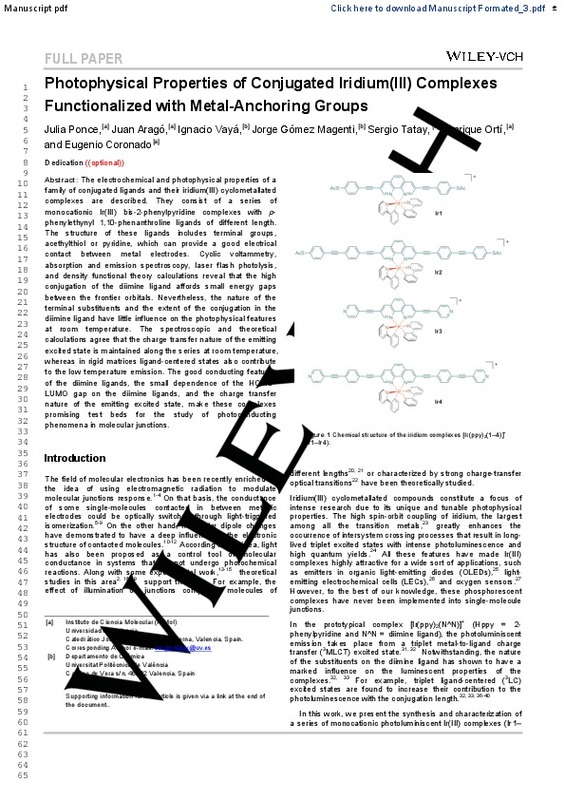JavaScript is disabled for your browser. Some features of this site may not work without it.
Buscar en RiuNet
Listar
Mi cuenta
Estadísticas
Ayuda RiuNet
Admin. UPV
Photophysical Properties of Oligo(phenylene ethynylene) Iridium(III) Complexes Functionalized with Metal-Anchoring Groups
Mostrar el registro sencillo del ítem
Ficheros en el ítem
| dc.contributor.author | Ponce, Julia
|
es_ES |
| dc.contributor.author | Arago, Juan
|
es_ES |
| dc.contributor.author | Vayá Pérez, Ignacio
|
es_ES |
| dc.contributor.author | Gómez Magenti, Jorge
|
es_ES |
| dc.contributor.author | Tatay, Sergio
|
es_ES |
| dc.contributor.author | Ortí, Enrique
|
es_ES |
| dc.contributor.author | Coronado, Eugenio
|
es_ES |
| dc.date.accessioned | 2022-01-20T19:30:41Z | |
| dc.date.available | 2022-01-20T19:30:41Z | |
| dc.date.issued | 2016-04 | es_ES |
| dc.identifier.issn | 1434-1948 | es_ES |
| dc.identifier.uri | http://hdl.handle.net/10251/180039 | |
| dc.description.abstract | [EN] The electrochemical and photophysical properties of a family of conjugated ligands and their iridium(III) cyclometallated complexes are described. They consist of a series of monocationic Ir-III bis-2-phenylpyridine complexes with p-phenylethynyl-1,10-phenanthroline ligands of different length. The structure of these ligands includes terminal acetylthiol or pyridine groups, which can provide good electrical contacts between metal electrodes. Cyclic voltammetry, absorption and emission spectroscopy, laser flash photolysis and density functional theory calculations reveal that the high conjugation of the diimine ligand affords small energy gaps between the frontier orbitals. Nevertheless, the nature of the terminal substituents and the extent of the conjugation in the diimine ligand have little influence on the photophysical features at room temperature. The spectroscopic data and theoretical calculations agree that the charge-transfer nature of the emitting excited state is maintained along the series at room temperature, whereas in rigid matrices ligand-centred states also contribute to the low-temperature emission. The good conducting features of the diimine ligands, the small dependence of the HOMO-LUMO (HOMO = highest occupied molecular orbital, LUMO = lowest unoccupied molecular orbital) gaps of these complexes on the ligands and the charge-transfer nature of the emitting excited state make these complexes promising test beds for the study of photo-conducting phenomena in molecular junctions. | es_ES |
| dc.description.sponsorship | The authors would like to especially acknowledge Prof. Hans U. Gudel for his valuable inspiration and friendship. The present work has been funded by the European Union (EU), (ERC Advanced Grant SPINMOL), the Spanish Ministerio de Economia y Competitividad (MINECO) (projects MAT2014-56243, CTQ2015-71154, and Unidad de Excelencia Maria de Maeztu MDM-2015-0552), and the Generalitat Valenciana (Prometeo/2012/053, PrometeoII/2013/006 and ISIC-Nano). J. P., I. V. and S. T. thank the Ministerio de Ciencia e Innovacion (MICINN) for their predoctoral fellowships and JdlC contracts. J. A., I. V., and S. T. also thank the European Union (EU) for their FP7-PEOPLE-2012-IEF-329513, PCIG12GA-2012-334257 and MSCA-IF-657465, and FP7-PEOPLE-2012-CIG-321739 grants, respectively. | es_ES |
| dc.language | Inglés | es_ES |
| dc.publisher | John Wiley & Sons | es_ES |
| dc.relation.ispartof | European Journal of Inorganic Chemistry | es_ES |
| dc.rights | Reserva de todos los derechos | es_ES |
| dc.subject | Laser flash photolysis | es_ES |
| dc.subject | Fluorescence | es_ES |
| dc.subject | Ir complexes | es_ES |
| dc.subject | MLCT | es_ES |
| dc.subject | LLCT | es_ES |
| dc.subject.classification | QUIMICA ORGANICA | es_ES |
| dc.title | Photophysical Properties of Oligo(phenylene ethynylene) Iridium(III) Complexes Functionalized with Metal-Anchoring Groups | es_ES |
| dc.type | Artículo | es_ES |
| dc.identifier.doi | 10.1002/ejic.201501409 | es_ES |
| dc.relation.projectID | info:eu-repo/grantAgreement/EC/FP7/321739/EU/ | es_ES |
| dc.relation.projectID | info:eu-repo/grantAgreement/MINECO//MAT2014-56243/ | es_ES |
| dc.relation.projectID | info:eu-repo/grantAgreement/EC/FP7/329513/EU/ | es_ES |
| dc.relation.projectID | info:eu-repo/grantAgreement/GVA//Prometeo%2F2012%2F053/ | es_ES |
| dc.relation.projectID | info:eu-repo/grantAgreement/EC/FP7/334257/EU/ | es_ES |
| dc.relation.projectID | info:eu-repo/grantAgreement/GVA//PrometeoII%2F2013%2F006/ | es_ES |
| dc.relation.projectID | info:eu-repo/grantAgreement/EC/H2020/657465/EU/ | es_ES |
| dc.relation.projectID | info:eu-repo/grantAgreement/MINISTERIO DE EDUCACION //JCI-2011-09926//AYUDA JUAN DE LA CIERVA 2011-VAYA PEREZ/ | es_ES |
| dc.relation.projectID | info:eu-repo/grantAgreement/MINECO//CTQ2015-71154-P/ES/SISTEMAS MOLECULARES ELECTROACTIVOS: ESTRUCTURA ELECTRONICA, PROPIEDADES OPTICAS Y ORGANIZACION SUPRAMOLECULAR/ | es_ES |
| dc.relation.projectID | info:eu-repo/grantAgreement/MINECO//MDM-2015-0552/ES/INSTITUT DE CIENCIA I TECNOLOGIA AMBIENTALS - ICTA/ | es_ES |
| dc.rights.accessRights | Abierto | es_ES |
| dc.description.bibliographicCitation | Ponce, J.; Arago, J.; Vayá Pérez, I.; Gómez Magenti, J.; Tatay, S.; Ortí, E.; Coronado, E. (2016). Photophysical Properties of Oligo(phenylene ethynylene) Iridium(III) Complexes Functionalized with Metal-Anchoring Groups. European Journal of Inorganic Chemistry. (12):1851-1859. https://doi.org/10.1002/ejic.201501409 | es_ES |
| dc.description.accrualMethod | S | es_ES |
| dc.relation.publisherversion | https://doi.org/10.1002/ejic.201501409 | es_ES |
| dc.description.upvformatpinicio | 1851 | es_ES |
| dc.description.upvformatpfin | 1859 | es_ES |
| dc.type.version | info:eu-repo/semantics/publishedVersion | es_ES |
| dc.description.issue | 12 | es_ES |
| dc.relation.pasarela | S\413441 | es_ES |
| dc.contributor.funder | European Commission | es_ES |
| dc.contributor.funder | Generalitat Valenciana | es_ES |
| dc.contributor.funder | MINISTERIO DE EDUCACION | es_ES |
| dc.contributor.funder | COMISION DE LAS COMUNIDADES EUROPEA | es_ES |
| dc.contributor.funder | Ministerio de Economía y Competitividad | es_ES |







![[Cerrado]](/themes/UPV/images/candado.png)

